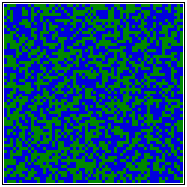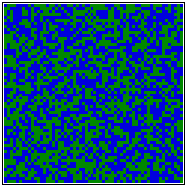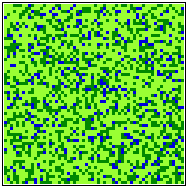
(13 images)
Following the so-called "model of multigrain growth of 123/211 composites
" developed in the SUPRAS
group, we obtained simulated microstructures quite similar to what is observed
in the laboratory. Please find herebelow four examples of simulated microstructures.
The constraints of this multigrain growth model of YBa2Cu3O7-x/Y2BaCuO5
composites have been
(i) an isothermal undercooling below the peritectic temperature,
(ii) the peritectic chemical reaction and the 211 dissolution, and
(iii) the pushing or trapping of the 211 particles.
The multigrain growth model considers as input (i) the melt composition
and (ii) the 211 size distribution respectively through the set of parameters
s211 and l211. The parameter s211 is the probability to have a small 211
particle on a lattice site and the parameter l211 is the probability to have
a large 211 particle on a lattice site. The stoichiometric melt composition
corresponds to a line of slope -1/2 in the (s211,l211) parameter plane. A
211 unimodal size distribution corresponds to an end point on the latter
line. In between these end points, the choice of a specific 211 size distribution
is allowed.
In the movies presented herebelow: green squares represent 211 solid (mesoscopic)
units, light green squares represent 211 particles embedded in the liquid
L-phase, blue squares represent L mesoscopic units and grain boundaries are
represented in red.
1. A starting melt of stoichiometric composition 123 containing
only large 211 particles (s211=0, l211=0.5). Particles are static hindrances
for the growth.

(13 images)
2. The same starting situation as (1) but the 211 particles
are now pushed by the 123 growing interfaces.

(24 images)
It is obvious that the dynamical interaction between the 123 growing front
and the 211 particles has an effect on the produciton of 123 phase and on
the microstructure.
3. The starting melt has a soichiometric composition 123 with 20%
211 phase in excess (s211=0.0, l211=0.6). The particles are mobile hindrances
for the growing 123/L interface.

(21 images)
4. The starting melt has a soichiometric composition 123 with 20%
211 phase in excess (s211=0.6, l211=0.3), i.e. the same composition as for
(3) but with many more small particles in the initial melt. The particles
are mobile hindrances for the growing 123/L interface.

(22 images)
It is obvious that the 211 size distribution in the initial melt has an
important effect on the resulting microstructures. Moreover, an excess of
211 phase reduces the amount of liquid phase remaining usually at the grain
boundaries. In these simulations, the best situation was found to be for
a 20% 211 initial excess, - a value in quite good agreement with experimental
findings.